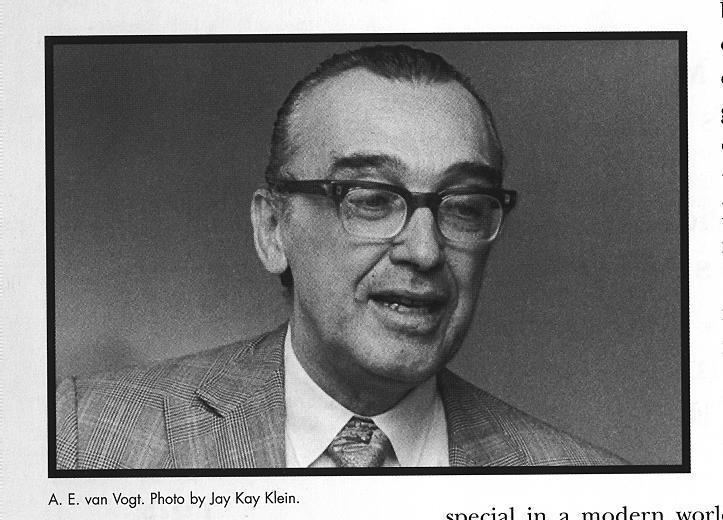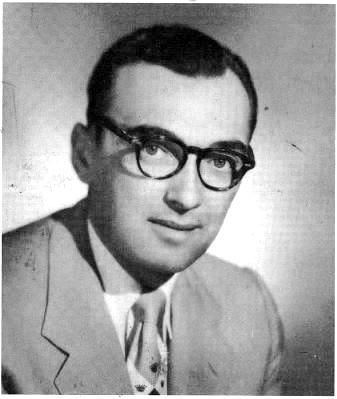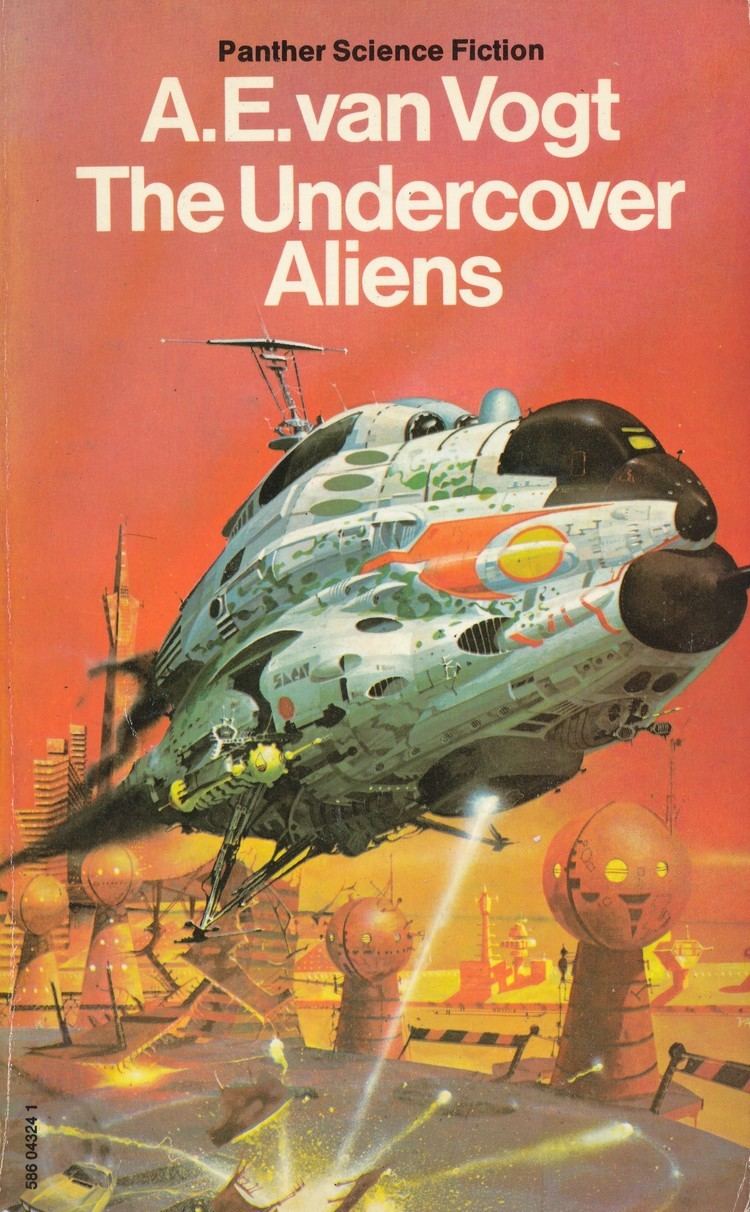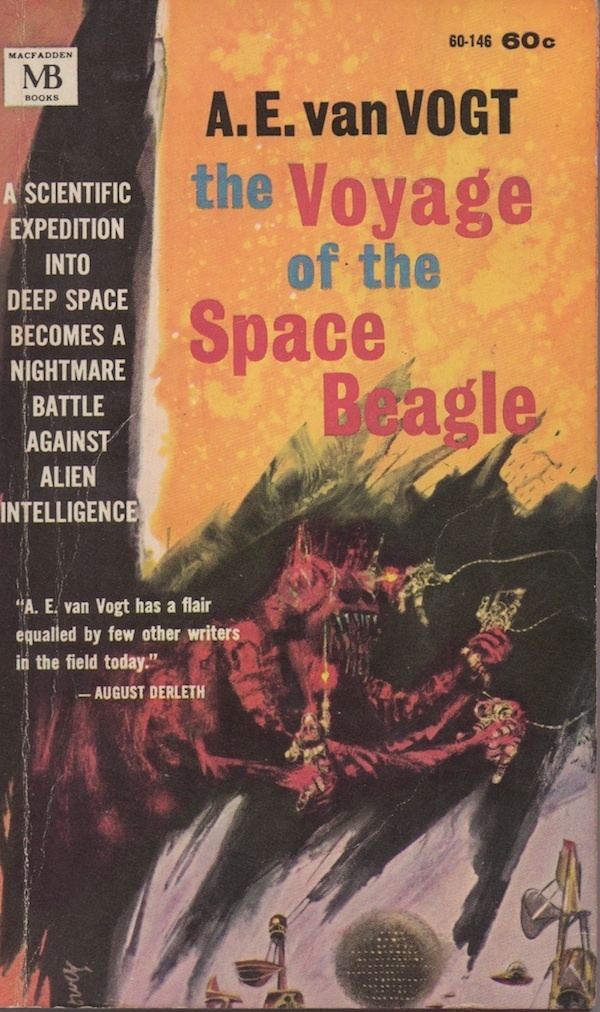Occupation Writer Name A. van Nationality Canadian Role Author | Genre Science fiction Movies Four Short Films Signature | |
 | ||
Born Alfred Elton van VogtApril 26, 1912Gretna, Manitoba, Canada ( 1912-04-26 ) Period 1939–1986 (science fiction) Died January 26, 2000, Hollywood, California, United States Books Slan, The World of Null‑A, The Voyage of the Spac, The Weapon Shops of I, The Weapon Makers Similar People Poul Anderson, Jack Williamson, John W Campbell, Philip K Dick, Edna Mayne Hull | ||
A e van vogt quotes
Alfred Elton van Vogt (; April 26, 1912 – January 26, 2000) was a Canadian-born science fiction author. He is regarded as one of the most popular, influential and complex practitioners of the mid-twentieth century, the genre's so-called Golden Age.
Contents
- A e van vogt quotes
- In the Footsteps of ASTOUNDING part two A E Van VogtRGBIB Ep 72
- Early life and writings
- Post war life and work
- Critical reception
- Recognition
- Novels
- Collections
- Nonfiction
- References

In the Footsteps of ASTOUNDING, part two: A. E. Van Vogt–RGBIB Ep. 72
Early life and writings

Van Vogt was born on a farm in Edenburg (a Russian Mennonite community east of Gretna, Manitoba, Canada). Until age four, van Vogt and his family spoke only a dialect of Low German at home. Van Vogt's father, a lawyer, moved his family several times. His son found these moves difficult, remarking in later life:

Childhood was a terrible period for me. I was like a ship without anchor being swept along through darkness in a storm. Again and again I sought shelter, only to be forced out of it by something new.

After starting his writing career by writing for true-confession style pulp magazines such as True Story, van Vogt decided to switch to writing something he enjoyed, science fiction. He was inspired by the August 1938 issue of Astounding Science Fiction, which he picked up at a newsstand. The story "Who Goes There?" led him to write "Vault of the Beast", which he submitted to that same magazine. It was rejected, but the rejection letter encouraged him to try again. He sent in a story called "Black Destroyer," which was accepted. A rewritten version of "Vault of the Beast" would be published in 1940.

Van Vogt's first SF publication was inspired by The Voyage of the Beagle by Charles Darwin. "The Black Destroyer" was published in July 1939 by John W. Campbell in Astounding Science Fiction, the centennial year of Darwin's journal. It featured a fierce, carnivorous alien, the coeurl, stalking the crew of an exploration spaceship. "Discord in Scarlet" was his second story to be published, also appearing as the cover story. It was accompanied by interior illustrations created by Frank Kramer and Paul Orban. (Van Vogt and Kramer thus debuted in the issue of Astounding that is sometimes singled out for ushering in the "Golden Age" of science fiction.) The former story served as the inspiration for multiple science fiction movies. In 1950, the two were combined with two other stories as a fix-up novel, The Voyage of the Space Beagle (Simon & Schuster), which was published in at least five European languages by 1955. Positing the need for exobiologists who will appreciate the differences between the inhabitants of other planets and ourselves, it stresses the importance of the civilian rather than military in exploration of other cultures.
Van Vogt's first completed novel, and one of his most famous, is Slan (Arkham House, 1946), which Campbell serialized in Astounding September to December 1940. Using what became one of van Vogt's recurring themes, it told the story of a 9-year-old superman living in a world in which his kind are slain by Homo sapiens.
In 1941, van Vogt decided to become a full-time writer, quitting his job at the Canadian Department of National Defence. Prolific for a few years, van Vogt wrote many short stories. In the 1950s, many of them were retrospectively patched together into novels, or "fixups" as he called them, a term that entered the vocabulary of science-fiction criticism. When the original stories were related (e.g., The War against the Rull) this was often successful. When not (e.g., Quest for the Future) the disparate stories thrown together generally made for a less coherent plot.
Post-war life and work
In 1944, van Vogt moved to Hollywood, where his writing took on new dimensions after World War II. He was always interested in the idea of all-encompassing systems of knowledge (akin to modern meta-systems)—the characters in his very first story used a system called "Nexialism" to analyze the alien's behavior, and he became interested in the general semantics of Alfred Korzybski.
He subsequently wrote three novels merging these overarching themes, The World of Null-A and The Pawns of Null-A in the late 1940s, and Null-A Three in the early 1980s. Null-A, or non-Aristotelian logic, refers to the capacity for, and practice of, using intuitive, inductive reasoning (compare fuzzy logic), rather than reflexive, or conditioned, deductive reasoning.
Van Vogt was profoundly affected by revelations of totalitarian police states that emerged after World War II. He wrote a mainstream novel that he set in Communist China, The Violent Man (1962); he said that to research this book he had read 100 books about China. Into this book he incorporated his view of "the violent male type", which he described as a "man who had to be right", a man who "instantly attracts women" and who he said were the men who "run the world".
At the same time, in his fiction, van Vogt was consistently sympathetic to absolute monarchy as a form of government. This was the case, for instance, in the Weapon Shop series, the Mixed Men series, and in single stories such as "Heir Apparent" (1945), whose protagonist was described as a "benevolent dictator".
Van Vogt systematized his writing method, using scenes of 800 words or so where a new complication was added or something resolved. Several of his stories hinge on temporal conundra, a favorite theme. He stated that he acquired many of his writing techniques from three books: Narrative Technique by Thomas Uzzell, The Only Two Ways to Write a Story by John Gallishaw, and Twenty Problems of the Fiction Writer by Gallishaw.
He also claimed many of his ideas came from dreams; throughout his writing life he arranged to be awakened every 90 minutes during his sleep period so he could write down his dreams.
Van Vogt published perhaps his most famous story, "Enchanted Village", in the July 1950 issue of Other Worlds Science Stories. It was reprinted in over 20 collections or anthologies, and appeared many times in translation.
In 1950, van Vogt was briefly appointed as head of L. Ron Hubbard's Dianetics operation in California. Dianetics was the secular precursor to Hubbard's Church of Scientology. The operation went broke nine months later, but never went bankrupt, due to van Vogt's arrangements with creditors. Van Vogt and his wife opened their own Dianetics centre, partly financed by his writings, until he "signed off" around 1961. At the time of his interview with Charles Platt, van Vogt was still president of the Californian Association of Dianetic Auditors.
In 1951, he published The Weapon Shops of Isher. In the same decade, van Vogt also produced collections and fixups such as The Mixed Men (1952), The War Against the Rull (1959), and the two "Clane" novels, Empire of the Atom (1957) and The Wizard of Linn (1962), which were inspired (like Asimov's Foundation series) by Roman imperial history, specifically the reign of Claudius. His later novels included fixups such as The Beast (also known as Moonbeast) (1963), Rogue Ship (1965), Quest for the Future (1970) and Supermind (1977); expanded short stories (The Darkness on Diamondia (1972), Future Glitter (also known as Tyranopolis; 1973); original novels such as Children of Tomorrow (1970), The Battle of Forever (1971) and The Anarchistic Colossus (1977); plus sequels to his classic works, many of which were promised, but only one of which appeared, Null-A Three (1984; originally published in French). Several later books were original in Europe, and at least one novel only ever appeared in Italian.
On January 26, 2000, van Vogt died in Los Angeles, United States from Alzheimer's disease, survived by his second wife, the former Lydia Bereginsky.
Critical reception
Critical opinion about the quality of van Vogt's work is sharply divided.
One early and articulate critic was Damon Knight. In a 1945 chapter-long essay reprinted in In Search of Wonder, entitled "Cosmic Jerrybuilder: A. E. van Vogt", Knight famously remarked that van Vogt "is no giant; he is a pygmy who has learned to operate an overgrown typewriter". Knight described The World of Null-A as "one of the worst allegedly adult science fiction stories ever published". About van Vogt's writing, Knight said:
In general van Vogt seems to me to fail consistently as a writer in these elementary ways: 1. His plots do not bear examination. 2. His choice of words and his sentence-structure are fumbling and insensitive. 3. He is unable either to visualize a scene or to make a character seem real.
About Empire of the Atom Knight wrote:
If you can only throw your reasoning powers out of gear—something many van Vogt fans find easy to do—you'll enjoy this one.
Knight also expressed misgivings about van Vogt's politics, noting that his stories almost invariably present absolute monarchy in a favorable light. But in 1974, he went partly back on his criticism after finding out about Vogt's working methods about writing down his dreams:
This explains a good deal about the stories, and suggests that it is really useless to attack them by conventional standards. If the stories have a dream consistency which affects readers powerfully, it is probably irrelevant that they lack ordinary consistency.
On the other hand, when science fiction author Philip K. Dick was asked which science fiction writers had influenced his work the most, he replied:
I started reading sf when I was about twelve and I read all I could, so any author who was writing about that time, I read. But there's no doubt who got me off originally and that was A.E. van Vogt. There was in van Vogt's writing a mysterious quality, and this was especially true in The World of Null A. All the parts of that book did not add up; all the ingredients did not make a coherency. Now some people are put off by that. They think that's sloppy and wrong, but the thing that fascinated me so much was that this resembled reality more than anybody else's writing inside or outside science fiction.
Dick also defended van Vogt against Damon Knight’s criticisms:
Damon feels that it's bad artistry when you build those funky universes where people fall through the floor. It's like he's viewing a story the way a building inspector would when he's building your house. But reality really is a mess, and yet it's exciting. The basic thing is, how frightened are you of chaos? And how happy are you with order? Van Vogt influenced me so much because he made me appreciate a mysterious chaotic quality in the universe which is not to be feared.
In a review of Transfinite: The Essential A.E. van Vogt, science fiction writer Paul Di Filippo said:
Van Vogt knew precisely what he was doing in all areas of his fiction writing. There's hardly a wasted word in his stories... His plots are marvels of interlocking pieces, often ending in real surprises and shocks, genuine paradigm shifts, which are among the hardest conceptions to depict. And the intellectual material of his fictions, the conceits and tossed-off observations on culture and human and alien behavior, reflect a probing mind...Each tale contains a new angle, a unique slant, that makes it stand out.
In The John W. Campbell Letters, Campbell says, "The son-of-a-gun gets hold of you in the first paragraph, ties a knot around you, and keeps it tied in every paragraph thereafter—including the ultimate last one".
Harlan Ellison (who began reading van Vogt as a teenager) wrote, "Van was the first writer to shine light on the restricted ways in which I had been taught to view the universe and the human condition".
Writing in 1984 David Hartwell said:
No one has taken van Vogt seriously as a writer for a long time. Yet he has been read and still is. What no one seems to have noticed is that van Vogt, more than any other single SF writer, is the conduit through which the energy of Gernsbackian, primitive wonder stories have been transmitted through the Campbellian age, when earlier styles of SF were otherwise rejected, and on into SF of the present.
The literary critic Leslie A. Fiedler said something similar:
Van Vogt is a test case, ...since an apology for or analysis of science fiction which fails to come to terms with his appeal and major importance, defends or defines the genre by falsifying it.
The American literary critic Fredric Jameson says of van Vogt:
...that van Vogt's work clearly prepares the way for that of the greatest of all Science Fiction writers, Philip K. Dick, whose extraordinary novels and stories are inconceivable without the opening onto that play of unconscious materials and fantasy dynamics released by van Vogt, and very different from the more hard-science aesthetic ideologies of his contemporaries (from Campbell to Heinlein).
Nevertheless, van Vogt still has his critics. For example, Darrell Schweitzer writing to The New York Review of Science Fiction in 1999 quoted a passage from the original van Vogt novelette "The Mixed Men", which he was then reading, and remarked:
This is the realism, and logic, of a small boy playing with toy soldiers in a sandbox. I'm tougher than you. I’ve got a billion spaceships! They’re brand-new. They only took 800 years to develop.
And this is a story in which most of the cast either have two brains or are really robots...and even the emotions of the human characters are programmed or deprogrammed as part of plots within counter plots. Next to this, Doc Smith was an icy realist. There is no intersection with adult reality at any point, for all van Vogt was able to write was that small boy's sandbox game with an adult level of intensity. This is, I think, the secret of van Vogt's bizarre fascination, as awful as his actual writing might be, and why he appealed so strongly to Philip K. Dick, who managed to put more adult characters and emotions into equally crazy situations. It's ultimately very strange to find this sort of writing so prominently sponsored by supposedly rational and scientifically minded John W. Campbell, when it seems to contravene everything the Golden Age stood for.
Recognition
In 1946, van Vogt and his first wife, Edna Mayne Hull, were Guests of Honor at the fourth World Science Fiction Convention.
In 1980, van Vogt received a "Casper Award" (precursor to the Canadian Prix Aurora Awards) for Lifetime Achievement.
The Science Fiction Writers of America named him its 14th Grand Master in 1995 (presented 1996). Great controversy within SFWA accompanied its long wait in bestowing its highest honor (limited to living writers, no more than one annually). Writing an obituary of van Vogt, Robert J. Sawyer, a fellow Canadian writer of science fiction remarked:
There was no doubt that van Vogt should have received this honor much earlier — the injustice of him being overlooked, at least in part because of damnable SFWA politics, had so incensed Harlan Ellison, a man with an impeccable moral compass, that he'd lobbied hard on the Sci-Fi Channel and elsewhere on van Vogt's behalf.
It is generally held that the "damnable SFWA politics" concerns Damon Knight, the founder of the SFWA, who abhorred van Vogt's style and politics and thoroughly demolished his literary reputation in the 1950s.
Harlan Ellison was more explicit in 1999 introduction to Futures Past: The Best Short Fiction of A. E. van Vogt:
... at least I was able to make enough noise to get Van the Science Fiction Writers of America Grand Master Award, which was presented to him in full ceremony during one of the last moments when he was cogent and clearheaded enough to understand that finally, at last, dragged kicking and screaming to honor him, the generation that learned from what he did and what he had created had, at last, 'fessed up to his importance. ... were the same ones who assured me that Van would never get the Grand Master until Damon Knight had gotten it first, because Damon had loathed Van's work and had, in fact written the essay that ridiculed Van and held him up to opprobrium for decades thereafter, and Damon having founded SFWA it would be an affront to him if Van got it first. Well, I don't know if that's true or not, though it was common coin in the field for years; but Damon got the Grand Master award in 1994. And Van got it in 1995. As they say during sweeps week on television: coincidence or conspiracy?
In 1996, van Vogt received a Special Award from the World Science Fiction Convention "for six decades of golden age science fiction". That same year, the Science Fiction and Fantasy Hall of Fame inducted him in its inaugural class of two deceased and two living persons, along with writer Jack Williamson (also living) and editors Hugo Gernsback and John W. Campbell.
The works of van Vogt were translated into French by the surrealist Boris Vian (The World of Null-A as Le Monde des Å in 1958), and van Vogt's works were "viewed as great literature of the surrealist school". In addition, Slan was published in French, translated by Jean Rosenthal, under the title À la poursuite des Slans, as part of the paperback series 'Editions J'ai Lu: Romans-Texte Integral' in 1973, this edition also listing the following works by van Vogt as having been published in French as part of this series: Le Monde des Å, La faune de l'espace, Les joueurs du Å, L'empire de l'atome, Le sorcier de Linn, Les armureries d'Isher, Les fabricants d'armes, and Le livre de Ptath.
Novels
Primary dates represent first publication in book form.
